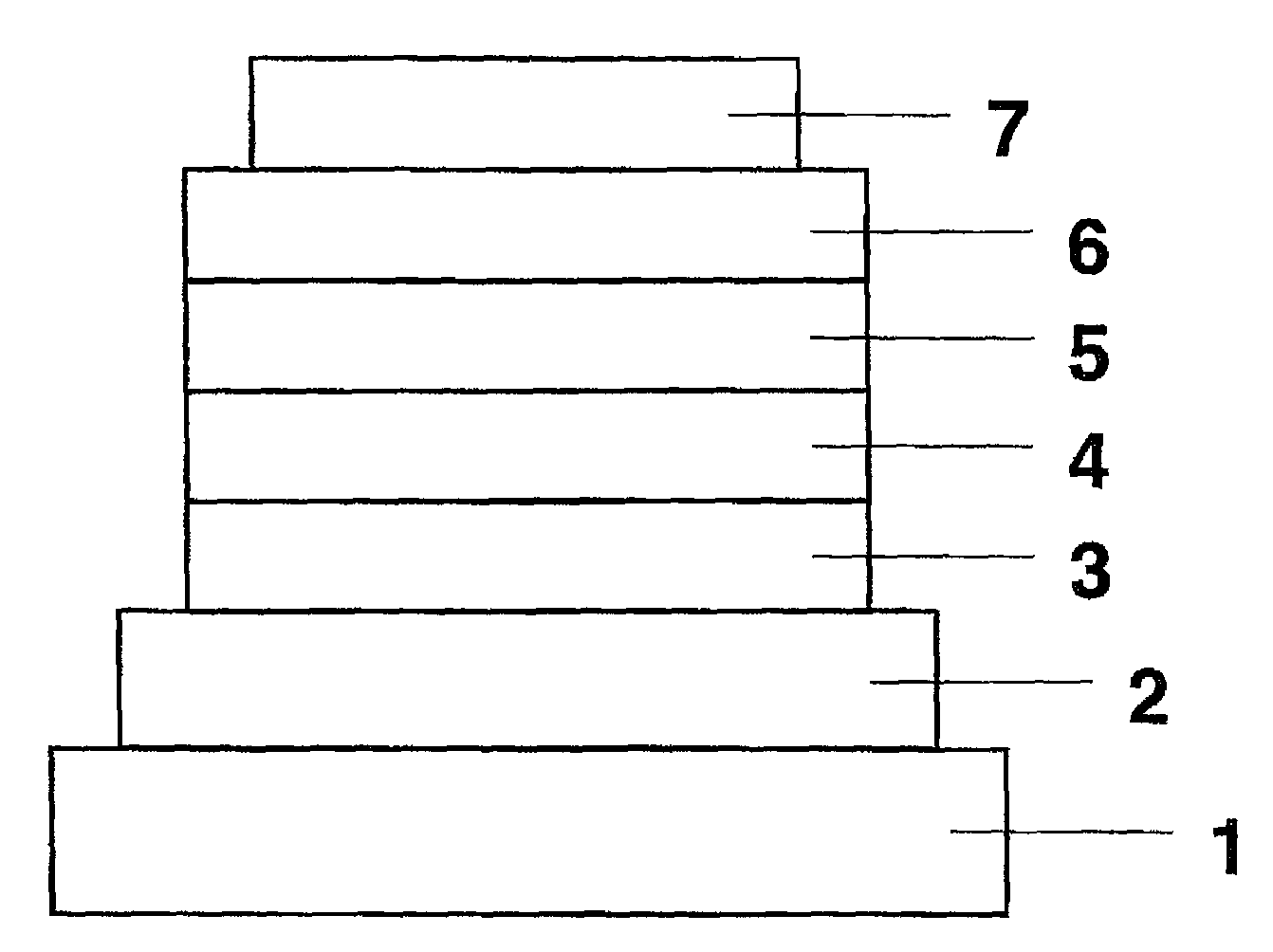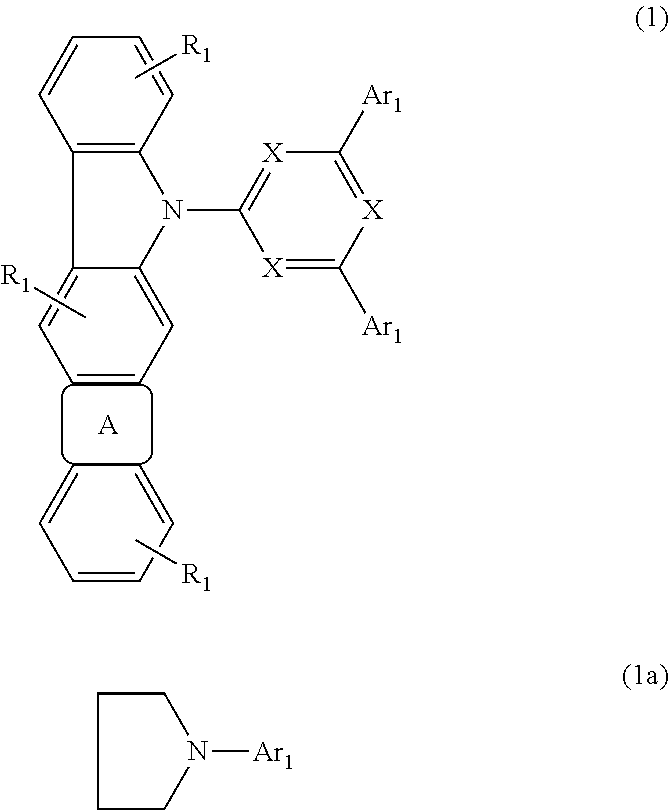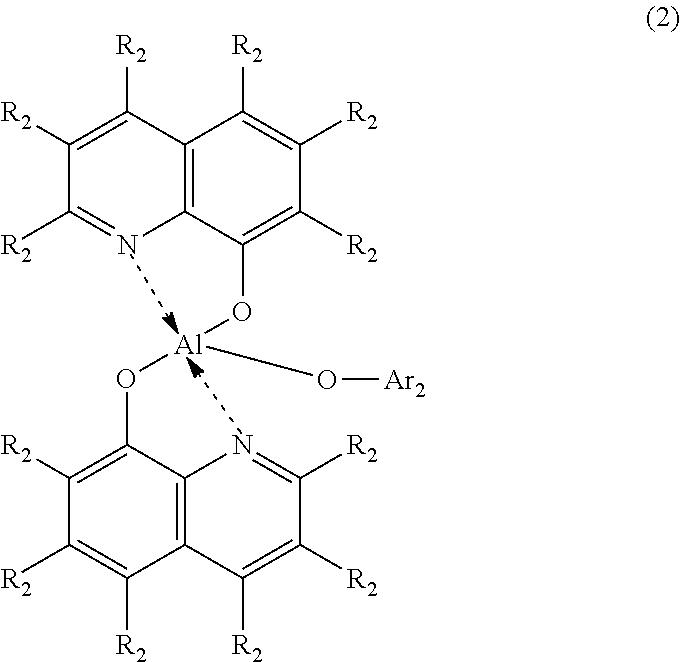Organic electroluminescent device having a light-emitting layer comprising a host material of two or more compounds
an electroluminescent device and organic technology, applied in the direction of discharge tube luminescnet screens, natural mineral layered products, etc., can solve the problems of lowering the luminous efficiency, increasing the driving voltage, and increasing the layer composed of arylamine compounds into the light-emitting layer, so as to secure the driving stability of the device, increase the luminous efficiency, and high efficiency
- Summary
- Abstract
- Description
- Claims
- Application Information
AI Technical Summary
Benefits of technology
Problems solved by technology
Method used
Image
Examples
example 1
[0081]An organic EL device constituted as in FIG. 1 with addition of an electron-injecting layer was fabricated. Applying the vacuum deposition process at a degree of vacuum of 4.0×10−4 Pa, the constituent layers were deposited in thin film one upon another on a glass substrate on which a 110 nm-thick ITO anode had been formed. First, CuPC was deposited on the ITO anode to a thickness of 30 nm as a hole-injecting layer and NPB was deposited to a thickness of 50 nm as a hole-transporting layer.
[0082]Then, a light-emitting layer was formed on the hole-transporting layer by co-depositing illustrated Compound 1-1, illustrated Compound 2-1, and illustrated Compound 3-1 as a host material and Ir(piq)2acac (illustrated Compound 4-8) as a dopant from different evaporation sources to a thickness of 40 nm. At this point, the co-deposition was performed under such conditions as to control the concentration of Ir(piq)2acac at 6.0 wt % and the weight ratio illustrated Compound 1-1:illustrated Co...
examples 2-13
[0084]Organic EL devices were fabricated as in Example 1 with the exception of changing the host materials incorporated in the light-emitting layer as shown in Table 1 and their luminous characteristics and luminance half life were evaluated. The vacuum deposition of the compounds of general formulas (1), (2), and (3) was performed under such conditions as to control the weight ratio after the vacuum deposition at 1:1 when two kinds were used or at 1:1:1 when three kinds were used. The results are shown in Table 1. The maximum wavelength of the spectrum of light emitted from the device was 620 nm and this proves that light is emitted from Ir(piq)2acac.
example 14
[0087]An organic EL device constituted as in FIG. 1 with addition of an electron-injecting layer was fabricated. Applying the vacuum deposition process at a degree of vacuum of 4.0×10−4 Pa, the constituent layers were deposited in thin film one upon another on a glass substrate on which a 110 nm-thick ITO anode had been formed. First, CuPC was deposited on the ITO anode to a thickness of 30 nm as a hole-injecting layer and then NPB was deposited to a thickness of 50 nm as a hole-transporting layer.
[0088]Next, a light-emitting layer was formed on the hole-transporting layer by co-depositing illustrated Compound 2-1 and illustrated Compound 3-1 as a host material and Ir(piq)2acac (illustrated Compound 4-8) as a dopant from different evaporation sources to a thickness of 40 nm. At this point, the co-deposition was performed under such conditions as to control the concentration of Ir(piq)2acac at 6.0 wt % and the weight ratio illustrated Compound 2-1:illustrated Compound 3-1 at 1:1. The...
PUM
| Property | Measurement | Unit |
|---|---|---|
| emission peak wavelength | aaaaa | aaaaa |
| Tg | aaaaa | aaaaa |
| emission wavelength | aaaaa | aaaaa |
Abstract
Description
Claims
Application Information
 Login to view more
Login to view more - R&D Engineer
- R&D Manager
- IP Professional
- Industry Leading Data Capabilities
- Powerful AI technology
- Patent DNA Extraction
Browse by: Latest US Patents, China's latest patents, Technical Efficacy Thesaurus, Application Domain, Technology Topic.
© 2024 PatSnap. All rights reserved.Legal|Privacy policy|Modern Slavery Act Transparency Statement|Sitemap



